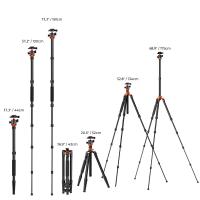Night Vision How It Works ?
Night vision technology works by amplifying the available light in low-light or dark environments to enhance visibility. There are different types of night vision devices, but most commonly, they use image intensification technology. This involves capturing the existing light through a lens and then passing it through an image intensifier tube.
Inside the image intensifier tube, the light is converted into electrons through a photocathode. These electrons are then accelerated and focused by an electric field, creating a brighter image. The intensified electrons strike a phosphor screen, which emits visible light, resulting in a greenish image that is viewed through an eyepiece.
Some night vision devices also incorporate infrared (IR) illuminators. These devices emit infrared light that is invisible to the human eye but can be detected by the night vision device. The IR light reflects off objects and is then captured and amplified, allowing for improved visibility in complete darkness.
Overall, night vision technology enables users to see in low-light conditions by amplifying available light or using infrared illumination, providing enhanced visibility and situational awareness.
1、 Photoreception in low light conditions
Night vision is the ability to see in low light conditions, and it is achieved through a process called photoreception. Photoreception refers to the detection of light by specialized cells in the eyes called photoreceptors. These photoreceptors are responsible for converting light into electrical signals that can be interpreted by the brain.
In low light conditions, the two main types of photoreceptors involved in night vision are rods and cones. Cones are responsible for color vision and work best in bright light, while rods are more sensitive to low levels of light and are responsible for black and white vision.
When light enters the eye, it passes through the cornea and lens, which focus the light onto the retina at the back of the eye. The rods and cones in the retina contain a pigment called rhodopsin, which is sensitive to light. When rhodopsin absorbs photons of light, it undergoes a chemical reaction that triggers a cascade of events, ultimately leading to the generation of electrical signals.
In low light conditions, the rods are more active than the cones. They contain a higher concentration of rhodopsin, making them more sensitive to light. This increased sensitivity allows the rods to detect even small amounts of light, enabling us to see in dimly lit environments.
Recent research has shed light on the molecular mechanisms underlying night vision. Scientists have discovered that a protein called RPE65 plays a crucial role in the regeneration of rhodopsin, allowing the rods to continuously function in low light conditions. Understanding these mechanisms has opened up new possibilities for developing treatments for vision disorders and improving night vision technologies.
In conclusion, night vision is achieved through the process of photoreception, where specialized cells in the eyes convert light into electrical signals. Rods, which are more sensitive to low levels of light, play a key role in night vision. Ongoing research continues to enhance our understanding of the molecular mechanisms involved in night vision, paving the way for advancements in vision-related treatments and technologies.

2、 Rod cells and their role in night vision
Rod cells and their role in night vision
Rod cells are specialized photoreceptor cells found in the retina of the eye. They play a crucial role in night vision by allowing us to see in low light conditions. Unlike cone cells, which are responsible for color vision and function best in bright light, rod cells are highly sensitive to light and are primarily responsible for our ability to see in dimly lit environments.
The key to rod cells' ability to function in low light conditions lies in their structure and the presence of a pigment called rhodopsin. Rhodopsin is a light-sensitive protein that is found in the outer segment of rod cells. When light enters the eye and reaches the rod cells, it is absorbed by the rhodopsin molecules, triggering a series of chemical reactions.
These chemical reactions cause the rhodopsin molecules to change shape, which in turn activates a cascade of events that ultimately leads to the generation of electrical signals. These electrical signals are then transmitted to the brain via the optic nerve, where they are interpreted as visual information.
The high sensitivity of rod cells to light is due to the fact that they contain a large number of rhodopsin molecules. This allows even small amounts of light to be detected and converted into electrical signals. Additionally, rod cells have a higher amplification system compared to cone cells, which further enhances their ability to detect and respond to low levels of light.
Recent research has shed light on the intricate mechanisms involved in rod cell function. Scientists have discovered that the process of rhodopsin regeneration, which is essential for sustained night vision, is more complex than previously thought. They have identified additional proteins and enzymes involved in this process, providing a deeper understanding of how rod cells adapt to changing light conditions.
In conclusion, rod cells are specialized photoreceptor cells that enable us to see in low light conditions. Their high sensitivity to light, coupled with the presence of rhodopsin, allows them to detect even small amounts of light and convert it into electrical signals. Ongoing research continues to unravel the intricacies of rod cell function, enhancing our understanding of night vision and its underlying mechanisms.

3、 Rhodopsin regeneration and adaptation to darkness
Night vision is the ability to see in low-light conditions, such as during the night or in dimly lit environments. It is made possible by two main processes: rhodopsin regeneration and adaptation to darkness.
Rhodopsin regeneration is a crucial aspect of night vision. Rhodopsin is a light-sensitive pigment found in the rod cells of the retina. When exposed to light, rhodopsin undergoes a chemical reaction that triggers a nerve impulse, allowing us to perceive light. However, this reaction also breaks down the rhodopsin molecule, rendering it inactive. In order to maintain night vision, the rhodopsin molecules need to be regenerated.
The regeneration of rhodopsin occurs in the dark. When the rod cells are not exposed to light, an enzyme called retinal isomerase converts the inactive form of rhodopsin back into its active form. This process takes time, which is why it takes a few minutes for our eyes to fully adjust to darkness.
Adaptation to darkness is another important factor in night vision. When we enter a dark environment, our eyes gradually adjust to the low-light conditions. This adaptation involves several physiological changes. The pupils dilate to allow more light to enter the eye, and the sensitivity of the rod cells increases. Additionally, the cones, which are responsible for color vision and work best in bright light, become less active in low-light conditions, allowing the rod cells to take over.
Recent research has shed light on the molecular mechanisms involved in rhodopsin regeneration and adaptation to darkness. Scientists have discovered specific proteins and signaling pathways that play a role in these processes. For example, a protein called RGR (retinal G protein-coupled receptor) has been found to be involved in the regeneration of rhodopsin. Understanding these mechanisms at a molecular level could potentially lead to the development of new treatments for vision disorders and improved night vision technologies.

4、 Neural processing of visual information in dim light
Night vision, also known as scotopic vision, refers to the ability to see in low light conditions. It is a fascinating phenomenon that allows humans and certain animals to navigate and perceive their surroundings when there is minimal available light. Night vision primarily relies on the neural processing of visual information in dim light.
The process of night vision begins with the activation of specialized cells in the retina called rod cells. Rod cells are highly sensitive to light and are responsible for detecting low levels of illumination. When exposed to dim light, rod cells undergo a chemical reaction that triggers the release of a neurotransmitter called glutamate. This neurotransmitter then stimulates the bipolar cells, which in turn activate the ganglion cells.
The ganglion cells are responsible for transmitting visual information from the retina to the brain. In the case of night vision, these cells have a higher convergence ratio, meaning that multiple rod cells can connect to a single ganglion cell. This increased convergence allows for the pooling of signals from multiple rod cells, enhancing the sensitivity to low light levels.
Once the visual information reaches the brain, it undergoes further processing in the visual cortex. Here, the brain integrates the signals from the ganglion cells and enhances the perception of contrast and edges, which are crucial for detecting objects in low light conditions.
Recent research has shed light on the molecular mechanisms underlying night vision. Scientists have discovered a protein called rhodopsin, which is found in rod cells and plays a vital role in the initial detection of light. Rhodopsin undergoes a conformational change upon absorbing light, triggering the cascade of events that lead to the release of glutamate and the activation of the visual pathway.
In conclusion, night vision is a complex process that involves the neural processing of visual information in dim light. It relies on the activation of rod cells, the transmission of signals through the visual pathway, and the integration of information in the brain. Ongoing research continues to uncover the intricate mechanisms underlying night vision, providing a deeper understanding of how our eyes adapt to low light conditions.







































